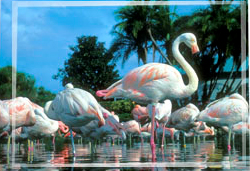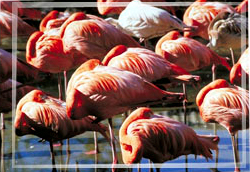Because flamingos have long legs, they can wade into much deeper water than most other birds. Webbed feet support them on soft mud.

There is no evidence that flamingos dive.
Flamingos are often seen in dense packs floating on the surface of the water.
RESPIRATION
Like other birds, flamingos breathe air with lungs. They hold their breath while feeding under water.
SLEEP
When flamingos are resting, they may sit down with their legs tucked beneath them or rest standing on one leg.

Flamingos often rest standing on one leg.
While resting, flamingos face into the wind. This stops wind and rain from penetrating their feathers. When resting on one leg, flamingos can be seen swaying back and forth in the wind.
THERMOREGULATION
Flamingos frequently stand on one leg. Curling a leg under the body keeps the foot warm and conserves body heat. Flamingos stand on one leg in both cool and warm environments.
FLIGHT
To take off, a flamingo runs several steps, begins flapping its wings, and lifts off into the air. When landing the procedure is reversed: the bird touches down and then runs several paces.
A flamingo flies with its head and neck stretched out in front and its legs trailing behind.
Flight speed of a flock of flamingos can reach 50 to 60 kph (31-37 mph).
Flamingos have been known to fly 500 to 600 km (311-373 mi.) each night between habitats.
ADAPTATIONS FOR A HIGH SALINITY ENVIRONMENT
The majority of lakes where flamingos live have extremely high salt concentrations. The only source of fresh water for some of these birds comes from boiling geysers. Flamingos are capable of drinking water at temperatures that approach the boiling point.
Flamingos excrete salt through salt glands in the nostrils.
VOCALIZATIONS
Flamingo vocalizations range from nasal honking to grunting or growling. Flamingos are generally very noisy birds. Variations exist in the voices of different species of flamingos.
Vocalizations play an important role in keeping flocks together as well as in ritualized displays. Specific calls are used in conjunction with certain behaviors.
Vocalizations are used in parent-chick recognition.
VISUAL DISPLAYS
Flamingos communicate with a broad range of visual displays.


